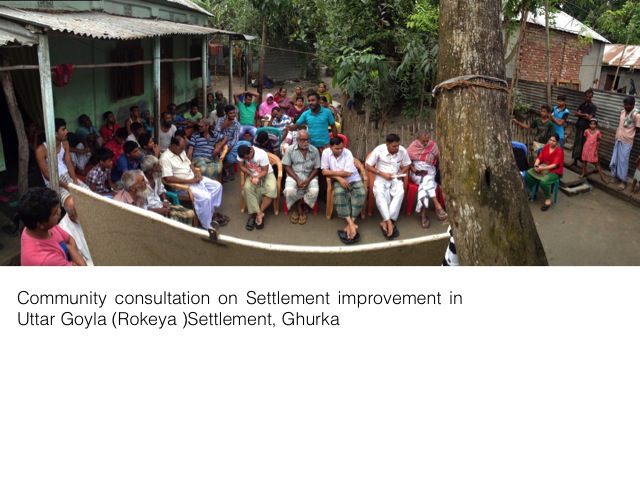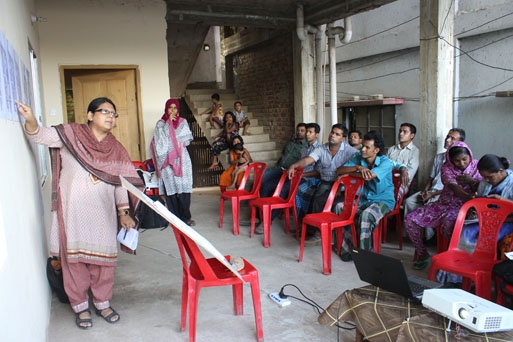 actions
actions
Community upgrading in Bangladesh: Amader Bari Amader Moto: “Our Home Our Way”
Two big projects are ongoing in Bangladesh, aiming at implementing a community driven upgrading for the first time at scale across this densely populated and still very poor country.
BRAC University, Manchester University, The National Housing Authority (NHA), Bangladesh World Bank, KMC, and JA Architects are working together on ‘Pro-poor Slum Integration Project’ (PPSIP), to develop city-wide community upgrading with/by/for low-income communities in urban areas of Bangladesh.
In parallel, the Urban Partnership for Poverty Reduction Project (UPPRP) is supported by UN-HABITAT in implementing the Community Housing Development programme, which is underway at Chittagong, Rajshahi and Shirajgonj districts. Working team includes Community Architects along with tenure advisor and urban planners.
In December 2014, Community Architects from PPSIP shared their work done in Comilla so far and the Community Architects from UPPRP shared their work from around the country at a sharing session. The participants talked about the lack of community architects working on the ground and whether community-led processes could be carried out without big funding agencies and finding ways to make these processes sustainable after the funding agencies leave. It was asserted that it is very possible to work with limited and no fund at all, but there’s a critical need to involve more professionals and students in participatory processes.
Comilla, Sirajganj, Dinajpur, Barisal and Narayanganj districts have been prioritized for the Pro-poor Slum Integration Project, and Comilla selected as the pilot. An extensive surveying of settlements was followed by a detailed census to prioritize where the upgrading would happen first. Out of the five settlements prioritized, only Shubhopur Gangpar community expressed interest to take part in the project.
For communities to come together, they often need something to come together on… Shubhopur Gangpar is a lakeside settlement. The government started building a road around the edge of the lake, but stopped the project at Shubhopur Gangpar due to lack of funding. Because access into the settlement is difficult, the community came together to continue the lake side road into the settlement.
A team of Community Architects started the design process by mapping with members of the community. To ease the process, the settlement was divided into four zones according to access. The four zones are not connected internally, and can only be accessed from the peripheral roads. Maps containing plot boundaries and existing structures were produced.
A series of “information maps” were also created that contained information about building typology, income, savings, interested-non interested ratio, owner-tenant ratio, membership in savings schemes, and aspiration maps containing information about what kind of intervention the people want on their houses. The architects digitized the community maps to make a Masterplan, including the new road, ghats, water purification systems, separate washing areas for females and males, play areas, and positioning of the new utilities (gas lines, water lines, electric poles and drains). Everyone in the community agreed to spare land for the new road along the lake.
In the following exercise community members were asked to draw their dream houses to scale on grid paper, and cost list the materials required for repairs or rebuilding. The community recorded whether individual households wished to repair or rebuild their houses and the size of loan needed, followed by a list of all the materials required across the community, and located where the best price was. The Community Architects will use these drawings to work on the technical drawings for the community.
In early 2014, students from the housing studio at the Department of Architecture at BRAC University went to five communities in Comilla and carried out design exercises. The students spent time with the residents of the communities, talked about their aspirations and needs, and designed hypothetical solutions for them.
The Social and Community Architect have recently began working in two communities in Sirajganj, the second town to receive the PPSIP program after Comilla. | Nazia Roushan
For more information on the PPSIP in Bangladesh, contact Nazia at naziaroushan@gmail.com
BRAC University, Manchester University, The National Housing Authority (NHA), Bangladesh World Bank, KMC, and JA Architects are working together on ‘Pro-poor Slum Integration Project’ (PPSIP), to develop city-wide community upgrading with/by/for low-income communities in urban areas of Bangladesh.
In parallel, the Urban Partnership for Poverty Reduction Project (UPPRP) is supported by UN-HABITAT in implementing the Community Housing Development programme, which is underway at Chittagong, Rajshahi and Shirajgonj districts. Working team includes Community Architects along with tenure advisor and urban planners.
In December 2014, Community Architects from PPSIP shared their work done in Comilla so far and the Community Architects from UPPRP shared their work from around the country at a sharing session. The participants talked about the lack of community architects working on the ground and whether community-led processes could be carried out without big funding agencies and finding ways to make these processes sustainable after the funding agencies leave. It was asserted that it is very possible to work with limited and no fund at all, but there’s a critical need to involve more professionals and students in participatory processes.
Comilla, Sirajganj, Dinajpur, Barisal and Narayanganj districts have been prioritized for the Pro-poor Slum Integration Project, and Comilla selected as the pilot. An extensive surveying of settlements was followed by a detailed census to prioritize where the upgrading would happen first. Out of the five settlements prioritized, only Shubhopur Gangpar community expressed interest to take part in the project.
For communities to come together, they often need something to come together on… Shubhopur Gangpar is a lakeside settlement. The government started building a road around the edge of the lake, but stopped the project at Shubhopur Gangpar due to lack of funding. Because access into the settlement is difficult, the community came together to continue the lake side road into the settlement.
A team of Community Architects started the design process by mapping with members of the community. To ease the process, the settlement was divided into four zones according to access. The four zones are not connected internally, and can only be accessed from the peripheral roads. Maps containing plot boundaries and existing structures were produced.
A series of “information maps” were also created that contained information about building typology, income, savings, interested-non interested ratio, owner-tenant ratio, membership in savings schemes, and aspiration maps containing information about what kind of intervention the people want on their houses. The architects digitized the community maps to make a Masterplan, including the new road, ghats, water purification systems, separate washing areas for females and males, play areas, and positioning of the new utilities (gas lines, water lines, electric poles and drains). Everyone in the community agreed to spare land for the new road along the lake.
In the following exercise community members were asked to draw their dream houses to scale on grid paper, and cost list the materials required for repairs or rebuilding. The community recorded whether individual households wished to repair or rebuild their houses and the size of loan needed, followed by a list of all the materials required across the community, and located where the best price was. The Community Architects will use these drawings to work on the technical drawings for the community.
In early 2014, students from the housing studio at the Department of Architecture at BRAC University went to five communities in Comilla and carried out design exercises. The students spent time with the residents of the communities, talked about their aspirations and needs, and designed hypothetical solutions for them.
The Social and Community Architect have recently began working in two communities in Sirajganj, the second town to receive the PPSIP program after Comilla. | Nazia Roushan
For more information on the PPSIP in Bangladesh, contact Nazia at naziaroushan@gmail.com
Location:
Bangladesh

Team:
BRAC University
Year:
2014
Community upgrading in Bangladesh: Amader Bari Amader Moto: “Our Home Our Way”




